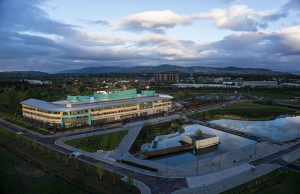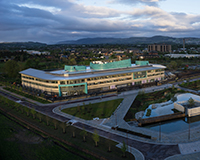 Inverness Campus, which occupies 215 acres at Beechwood alongside the capital of the Highlands, has chalked up several notable milestones this year on a journey you could say began some 50 years ago.
Inverness Campus, which occupies 215 acres at Beechwood alongside the capital of the Highlands, has chalked up several notable milestones this year on a journey you could say began some 50 years ago.
In May it had its official opening by Scotland’s deputy first minister, John Swinney. Then came the opening of the 200,000 sq ft Inverness College UHI and completion of a 10,000 sq ft centre for life sciences companies.
They are two elements of a first phase of development that will include, more than 500,000 sq ft of accommodation on 89 acres. Two subsequent phases, each occupying 63 acres and together offering 753,000 sq ft of accommodation, will be masterplanned between now and next Easter. All of this aims to create a major clustering and sharing of bio-science and health expertise.
But it was back in 1965 that the organisation now masterminding what is considered one of Scotland’s most ambitious economic developments, Highlands & Islands Enterprise (HIE), was formed as the Highlands and Islands Development Board. Its job was to stem the region’s then-damaging “brain drain” – blamed largely on an absence of its own university – by creating a more diverse economy.
A recognition in the early 1990s that it also needed to embrace the “knowledge economy” led to the launch of that fledgling university and eventually, in 2008, the Inverness Campus project was born with HIE’s purchase of the huge swathe of land it occupies today. It is already home to, among others, the university and the nearby incubator Centre for Health Science.
It is expected that the development, which is a 20- to 30-year project, will create up to 6,000 jobs and contribute £38m a year to the regional economy.
Ruaraidh MacNeil, project director for HIE, is in no doubt about the challenges of undertaking such a large and long-term project.
“Organisational stamina is required,” he says. “You have to maintain the original vision, level of ambition and quality of product over time in the face of many changes. There are budgetary pressures to face, too.”
As well as a collaborative approach to knowledge-sharing, Inverness Campus, which has so far seen investment of £100m, is also being driven by a joint approach to investment by the public, private and academic sectors. The HIE, which has committed around £25m to, among other things, infrastructure and site servicing, land acquisition, masterplanning and design, works with other partners, including NHS Highlands, the Highlands Council and the Scottish Funding Council.
MacNeil sees private-sector involvement growing over the next five to 10 years, but believes the HIE’s role will, for the time being, remain pivotal.
“While HIE is the major owner, I would expect public-sector investment in the scheme,” he says. “I don’t see HIE disposing of its interest for some time.”
The cornerpieces of phase one demonstrate a “whole mix of different funding models”, says MacNeil. A £7.5m student accommodation scheme, which began construction a few weeks ago, is being undertaken by a private developer; a £13m enterprise and research centre, which will house the HIE itself, four university research teams and the Rural College, has HIE, university and European funding. Inverness College is an NPD project – Scotland’s equivalent of PFI – while the life sciences facility is funded by HIE with support from the European Regional Development Fund.
Heads of terms are already being negotiated with a single occupier for the facility. MacNeil says, as a local landlord, HIE has an obligation to mirror local market conditions, “and here, like elsewhere, occupiers are looking for shorter leases and more flexibility”. Also, rents must reflect the market and the campus tone is £16.50 per sq ft.
Demand has been good, he says, with four organisations secured, one about to complete legals, and eight other “live” enquiries. “Our main focus, to date, has been bio-science and health, but we will broaden that out to attract other sectors, such as business services and energy.”
Many observers welcome Inverness Campus. Martin Gudaitis, retail and leisure specialist with Paradigm Asset Management, believes it will fuel demand that already exists for
Inverness from, among others, the restaurant sector by “bringing in a lot more expenditure”.
David Davidson, managing director (Scotland) of Cushman & Wakefield, says: “The health and bio-science market is one of the few viable targets that Scotland can and should be focusing on and what Inverness can offer will be distinctively different in terms of its location and city dynamic.”
A scenic setting and less competitive recruitment market are among its plus points, he says. “They are creating a genuine opportunity to get a floating requirement to land.”
Airport business park looks to take flight
Inverness Airport Business Park (IABP) first tried to take off in 2008 – only to be grounded by the recession. A healthier business climate and a relaunch of its promotional material are now delivering results, says Rory Black, business development manager for IABP. “Interest levels have increased a lot in the past six months,” he adds.
IABP, which next year will see the opening of a new rail connection and the start of direct flights to Heathrow, offers three development sites. A 36-acre phase one, undertaken with development partner Roxhill, is available to mixed-use occupiers. Black says availability of development land in Inverness is limited but local firms, whose order books are growing, want to expand. IABP now has six “realistic” enquiries and hopes for a first occupier announcement by the end of the year.
It also offers 10 acres of airside development land and a three-acre hotel site that is attracting expressions of interest from developers, says Black.











